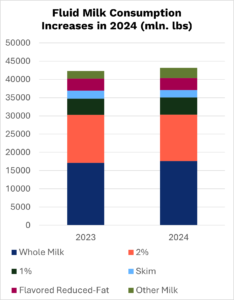The good news keeps coming for fluid milk.
According to year-end USDA data, fluid milk consumption, in a slow decline for the past five decades, increased in 2024. The 0.6% increase to 42.98 billion pounds is the first year-over-year gain since 2009. And unlike that year, it didn’t happen because low prices and a bad dairy economy prompted grocery stores to practically give it away. Milk prices are relatively high these days, and people are drinking more milk because… well, because they want to.
And the story isn’t just that they’re drinking more milk. It’s also about why they’re drinking milk, as well as what kind of milk they’re drinking.

Driving much consumer interest in real milk consumption is the awareness that it’s a protein powerhouse. And that’s only part of the unique package of essential nutrients milk has to offer that leaves over-engineered, nutritionally inferior plant-based substitutes in the dust. (Not to mention their many weird ingredients.)
Fluid milk’s gains are built on whole milk, also known as “the milk that tastes most like milk.” Not to begrudge lower-fat varieties — dairy farmers support whatever milk you choose, as long as it’s actual milk and not one of the misnamed beverages — but whole milk’s popularity shows just how intrinsically tasty dairy is, as well as how much more popular milk could be if it, say, were offered on a school lunch menu to children who drink it at home.
The increase also accentuates the lie of the plant-based imposters, which fell in sales for the third straight year. After years of their misinformation, painting their gains as inevitable, milk isn’t just getting back its market share — it’s adding to its already overwhelming preference in the marketplace. And no amount of over-processing of nut-of-the-moment re-engineering is going to change that.
And with that, it’s time for government policy to match consumer reality. The Whole Milk for Healthy Kids Act (which you can support here) would bring whole and 2% back to schools, giving schoolkids access to the same popular, healthy varieties they drink at home. And FDA’s enforcement of its own rules on milk’s Standard of Identity (or congressional passage of the Dairy PRIDE Act), would do a lot to clear up consumer confusion over nutrition in the marketplace.
Milk has a lot of momentum heading into the year — which, really, just puts it in the same position as the rest of dairy, the popularity of which remains the highest it’s been since the 1950s. So really — literally — raise a glass to this today. Because the number of glasses being raised is only growing.






